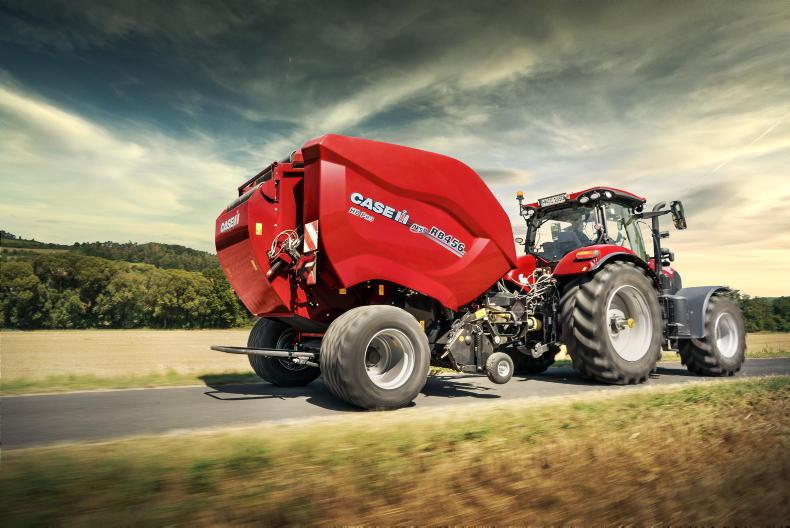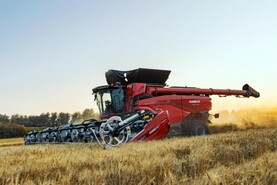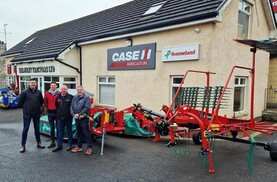Case IH has added to its range of variable chamber round balers with the new RB HD Pro.
The manufacturer says the new unit is designed to produce higher-density bales in a wide range of crops, from wet silage to dry straw.
Claiming the baler is capable of handling up to 30t per hour, Case IH says the RB HD Pro has been designed to manage everything from straw and hay to haylage and silage at different cut lengths, thanks to new no-slip dual drive rolls and a wide range of knife sets selectable from the cab.
It’s also fitted with a wider diameter rotor designed to help prevent blockages, while a new Active Drop Floor means any blockages can be cleared quickly.
The new balers come in two bale size options. The RB456 HD Pro makes 120cm-wide bales from 90cm to 165cm in diameter while the RB466 HD Pro’s are also 120cm wide but from 90cm up to 190cm in diameter.
Each size comes with three rotor options - a feeding rotor, 13 cutter knives or 25 cutter knives - making six models in all.
Case IH says the new baler has been put through its paces in testing and development, making 150,000 bales in a wide variety of crops and weather conditions with farmers around the world. The new RB HD Pro can be ordered from July 2022 for delivery in spring 2023.

The new balers come in two bale size options.
“We know that for farmers and contractors who use their balers a lot - typically 10,000 bales a year or more - durability and reliability are really important.
“With their needs in mind, we have looked at every aspect of the baler, not only to produce the best bales from every crop quickly, but also to make sure that they get them time after time after time,” says Michal Jankowski, Case IH product marketing manager.
“To do this, we have strengthened and enlarged the rolls, shafts and tailgate and introduced a more powerful gearbox and driveline – which also increases the numbers of bales per hour. In some places we have simplified things to help reliability and maintenance, for example reducing the number of driveline chains and sledge rolls.
“We have completely redesigned the bale chamber and belt path, to give us neatly formed, very dense bales that will stack well and efficiently. Bale size, wraps and density pressure can all be set up on the same screen page in the cab,” he concluded.
Case IH has added to its range of variable chamber round balers with the new RB HD Pro.
The manufacturer says the new unit is designed to produce higher-density bales in a wide range of crops, from wet silage to dry straw.
Claiming the baler is capable of handling up to 30t per hour, Case IH says the RB HD Pro has been designed to manage everything from straw and hay to haylage and silage at different cut lengths, thanks to new no-slip dual drive rolls and a wide range of knife sets selectable from the cab.
It’s also fitted with a wider diameter rotor designed to help prevent blockages, while a new Active Drop Floor means any blockages can be cleared quickly.
The new balers come in two bale size options. The RB456 HD Pro makes 120cm-wide bales from 90cm to 165cm in diameter while the RB466 HD Pro’s are also 120cm wide but from 90cm up to 190cm in diameter.
Each size comes with three rotor options - a feeding rotor, 13 cutter knives or 25 cutter knives - making six models in all.
Case IH says the new baler has been put through its paces in testing and development, making 150,000 bales in a wide variety of crops and weather conditions with farmers around the world. The new RB HD Pro can be ordered from July 2022 for delivery in spring 2023.

The new balers come in two bale size options.
“We know that for farmers and contractors who use their balers a lot - typically 10,000 bales a year or more - durability and reliability are really important.
“With their needs in mind, we have looked at every aspect of the baler, not only to produce the best bales from every crop quickly, but also to make sure that they get them time after time after time,” says Michal Jankowski, Case IH product marketing manager.
“To do this, we have strengthened and enlarged the rolls, shafts and tailgate and introduced a more powerful gearbox and driveline – which also increases the numbers of bales per hour. In some places we have simplified things to help reliability and maintenance, for example reducing the number of driveline chains and sledge rolls.
“We have completely redesigned the bale chamber and belt path, to give us neatly formed, very dense bales that will stack well and efficiently. Bale size, wraps and density pressure can all be set up on the same screen page in the cab,” he concluded.







 This is a subscriber-only article
This is a subscriber-only article










SHARING OPTIONS: